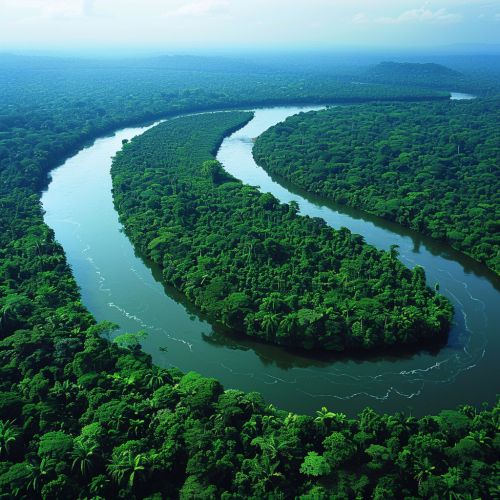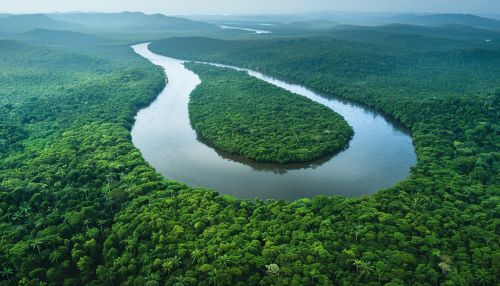Orinoco River: Difference between revisions
(Created page with "== Overview == The Orinoco River is one of the longest rivers in South America, flowing through Venezuela and Colombia. It spans approximately 2,140 kilometers (1,330 miles) and is a major waterway of the continent. The river's basin, known as the Orinoco Basin, covers an area of about 880,000 square kilometers (340,000 square miles), making it one of the largest river basins in the world. == Geography == The Orinoco River originates from the Parima Mountains, close to...") |
No edit summary |
||
| Line 17: | Line 17: | ||
The Delta Amacuro is a vast, swampy region where the Orinoco River splits into numerous distributaries before emptying into the Atlantic Ocean. This delta is rich in biodiversity and supports a variety of ecosystems, including mangroves, swamps, and marshes. | The Delta Amacuro is a vast, swampy region where the Orinoco River splits into numerous distributaries before emptying into the Atlantic Ocean. This delta is rich in biodiversity and supports a variety of ecosystems, including mangroves, swamps, and marshes. | ||
[[Image:Detail-92203.jpg|thumb|center|Aerial view of the Orinoco River winding through dense rainforest.|class=only_on_mobile]] | |||
[[Image:Detail-92204.jpg|thumb|center|Aerial view of the Orinoco River winding through dense rainforest.|class=only_on_desktop]] | |||
== Hydrology == | == Hydrology == | ||
Latest revision as of 17:41, 17 June 2024
Overview
The Orinoco River is one of the longest rivers in South America, flowing through Venezuela and Colombia. It spans approximately 2,140 kilometers (1,330 miles) and is a major waterway of the continent. The river's basin, known as the Orinoco Basin, covers an area of about 880,000 square kilometers (340,000 square miles), making it one of the largest river basins in the world.
Geography
The Orinoco River originates from the Parima Mountains, close to the Brazilian border, and flows in a giant arc through Venezuela before emptying into the Atlantic Ocean. The river's course is divided into four distinct sections: the Upper Orinoco, the Middle Orinoco, the Lower Orinoco, and the Delta Amacuro.
Upper Orinoco
The Upper Orinoco stretches from its source to the confluence with the Guaviare River. This section is characterized by rapid currents and numerous waterfalls, including the famous Angel Falls, the highest uninterrupted waterfall in the world.
Middle Orinoco
The Middle Orinoco extends from the Guaviare River confluence to the Atures Rapids. This segment is marked by a series of rapids and islands, making navigation challenging. The river widens considerably in this section, creating a diverse ecosystem that supports a variety of flora and fauna.
Lower Orinoco
The Lower Orinoco flows from the Atures Rapids to the Delta Amacuro. This part of the river is navigable and serves as a crucial transportation route for goods and people. The riverbanks are lined with dense rainforest, home to numerous species of plants and animals.
Delta Amacuro
The Delta Amacuro is a vast, swampy region where the Orinoco River splits into numerous distributaries before emptying into the Atlantic Ocean. This delta is rich in biodiversity and supports a variety of ecosystems, including mangroves, swamps, and marshes.


Hydrology
The Orinoco River's hydrology is influenced by seasonal rainfall patterns, with the highest water levels occurring during the rainy season from May to November. The river's flow rate can vary significantly, with peak discharges reaching up to 33,000 cubic meters per second. The river's sediment load is also substantial, contributing to the formation of the extensive delta region.
Biodiversity
The Orinoco River Basin is one of the most biodiverse regions on the planet. It is home to a wide array of species, including:
Flora
The basin's vegetation ranges from tropical rainforests to savannas. Key plant species include the Moriche Palm, which thrives in the swampy areas of the delta, and various species of bromeliads and orchids that adorn the forest canopy.
Fauna
The Orinoco River supports a diverse array of wildlife. Notable species include the Orinoco Crocodile, one of the largest crocodilian species, and the Amazon River Dolphin, known for its distinctive pink coloration. The river is also home to numerous fish species, including the piranha and the arapaima, one of the largest freshwater fish in the world.
Human Impact
The Orinoco River has been a vital resource for indigenous communities for thousands of years. These communities rely on the river for transportation, fishing, and agriculture. In recent years, however, the river has faced increasing pressures from industrial activities, including mining, deforestation, and hydroelectric projects.
Indigenous Communities
Indigenous groups such as the Yanomami and the Warao have traditionally inhabited the Orinoco Basin. These communities maintain a deep connection to the river and its ecosystems, utilizing traditional knowledge to sustainably manage their resources.
Industrial Activities
The Orinoco River Basin is rich in natural resources, including oil, gold, and timber. The extraction of these resources has led to environmental degradation, including deforestation, water pollution, and habitat destruction. Hydroelectric dams, such as the Guri Dam, have also altered the river's flow and impacted local ecosystems.
Conservation Efforts
Efforts to conserve the Orinoco River and its ecosystems are ongoing. Various national parks and protected areas have been established to safeguard the region's biodiversity. International organizations and local communities are also working together to promote sustainable development and mitigate the impacts of industrial activities.
